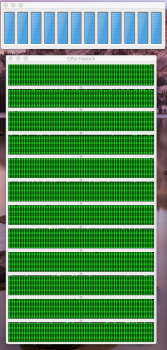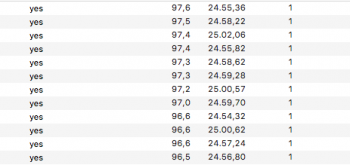Hey everyone!
Recently bought a Mac Pro with a W3565. Thought I would get the most out of my system so upgraded to W3690. It was my first time applying thermal paste (watched youtube guides) and I think it went pretty well.
Thought I would be safe about the installation so installed "Macs Fan Control". I read online about CPU stress test and this is the result after 12 * "yes > /dev/null &" in terminal for 25 minutes.
Do you think it looks fine? ? ?
In terms of the fans I observed the following when "CPU A core from PCECI" got close to 100C:
EXHAUST 600 RPM --> 800 RPM, approximately
INTAKE 600 RPM --> 800 RPM, approximately
BOOSTA 800 RPM --> 1200 RPM, approximately
After 10 seconds the system sort of stabilized and the 3 fans slowed down a bit as seen on the picture.
Overall I think that the fans of the system are working properly since they also slow down to stock RPM as soon as the heavy CPU load is cancelled.
I have attached a picture of the idle temperatures to - If something looks weird please do tell !
Any point in messing with settings of the fans "custom" vs "auto" unless you have installed another GPU and experience problems with "PCI" & "PS" fans (read that one thread the other day) ? ? ?
Thanks in advance !
Recently bought a Mac Pro with a W3565. Thought I would get the most out of my system so upgraded to W3690. It was my first time applying thermal paste (watched youtube guides) and I think it went pretty well.
Thought I would be safe about the installation so installed "Macs Fan Control". I read online about CPU stress test and this is the result after 12 * "yes > /dev/null &" in terminal for 25 minutes.
Do you think it looks fine? ? ?
In terms of the fans I observed the following when "CPU A core from PCECI" got close to 100C:
EXHAUST 600 RPM --> 800 RPM, approximately
INTAKE 600 RPM --> 800 RPM, approximately
BOOSTA 800 RPM --> 1200 RPM, approximately
After 10 seconds the system sort of stabilized and the 3 fans slowed down a bit as seen on the picture.
Overall I think that the fans of the system are working properly since they also slow down to stock RPM as soon as the heavy CPU load is cancelled.
I have attached a picture of the idle temperatures to - If something looks weird please do tell !
Any point in messing with settings of the fans "custom" vs "auto" unless you have installed another GPU and experience problems with "PCI" & "PS" fans (read that one thread the other day) ? ? ?
Thanks in advance !














